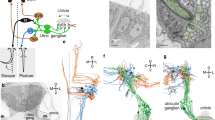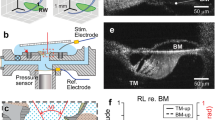Abstract
THE semicircular canal is considered classically to be a sensor of angular head motion during animal navigation; however, the functional significance of the canal's morphology and innervation for transduction and encoding of specific head trajectories is unclear. Neural responses from single afferent fibres innervating the crista of isolated elasmobranch labyrinths were used by Groen et al. to determine linear system coefficients of an overdamped pendulum equation, considered to reflect directly the dynamics of the motion of the cupula–endolymphatic fluid in the ampulla1. Similar studies on other preparations revealed certain neural response characteristics that were at variance with simple pendulum models, and these differences were ascribed variously to differences in hair cell physiology and afferent or efferent innervation properties, whose effects were superimposed on the fundamental fluid pendulum dynamics2–4. But in addition to these hypotheses based on cellular influences, the topological organisation of the receptor could result in specific afferent response characteristics deriving from different anatomical regions within the crista. As evidence for the latter, we report diverse classes of afferent responses, describable by distinctly different linear system equations, that are correlated with the position of separate bundles innervating specific areas of the crista of the guitarfish, Rhinobatos productus (Fig. 1).
This is a preview of subscription content, access via your institution
Access options
Subscribe to this journal
Receive 51 print issues and online access
$199.00 per year
only $3.90 per issue
Buy this article
- Purchase on Springer Link
- Instant access to full article PDF
Prices may be subject to local taxes which are calculated during checkout
Similar content being viewed by others
References
Groen, J. J., Lowenstein, O., and Vendrik, A. J. H., J. Physiol. Lond., 117, 329–346 (1952).
Fernandez, C., and Goldberg, J. M., J. Neurophysiol., 34, 661–675 (1971).
Precht, W., Llinás, R., and Clarke, M., Expl Brain Res., 13, 378–407 (1971).
Ledoux, A., Acta Oto-Rhino-Laryngol Belg., 12, 113–346 (1958).
Wersall, J., Acta Otolaryngol., Supp. 126 (1956).
Briggs, P. A. N., Hammond, P. H., Hughes, M. T. G., and Plumb, G. O., Proc. Inst. mech. Engng, 179, 37–51 (1965).
Davies, W. D. T., System identification for self-adaptive control (Wiley Interscience, London, 1970).
Godfrey, K. R., and Murgatroyd, W., Proc. Inst. elect. Engng, 111, 1803–1815 (1964).
Lee, Y. W., Statistical theory of communication (Wiley, New York, 1960).
Marmarelis, P. Z., and Naka, K.-I., J. Neurophysiol., 36, 605–617 (1973).
Milsum, J. H., Biological control systems analysis (McGraw-Hill, New York, 1966).
Whalen, A. D., Detection of signals in noise (Academic Press, New York, 1971).
Loewenstein, W. R., Principles of receptor physiology, handbook of sensory physiology, 1 (Springer, New York, 1971).
Author information
Authors and Affiliations
Rights and permissions
About this article
Cite this article
O'LEARY, D., DUNN, R. & HONRUBIA, V. Functional and anatomical correlation of afferent responses from the isolated semicircular canal. Nature 251, 225–227 (1974). https://doi.org/10.1038/251225a0
Received:
Revised:
Issue Date:
DOI: https://doi.org/10.1038/251225a0
This article is cited by
-
An angular acceleration receptor system of dual sensitivity in the statocyst ofOctopus vulgaris
Experientia (1985)
-
The response of theOctopus angular acceleration receptor system to sinusoidal stimulation
Journal of Comparative Physiology A (1985)
-
Magnets in guitarfish vestibular receptors
Experientia (1981)
-
Discharge properties of afferent fibres of the goldfish semicircular canal with high frequency stimulation
Pfl�gers Archiv European Journal of Physiology (1980)
-
A family of quasi-white random signals and its optimal use in biological system identification
Biological Cybernetics (1977)
Comments
By submitting a comment you agree to abide by our Terms and Community Guidelines. If you find something abusive or that does not comply with our terms or guidelines please flag it as inappropriate.



